AMAZON multi-meters discounts AMAZON oscilloscope discounts
A speaker in free air is like a fish out of water. Tests on un-baffled speakers
vs. properly enclosed speakers show that after installation in a suitable box
a speaker can deliver up to 100 times greater sound intensity at low frequencies
than it can in free air. The unbaffled speaker's lack of ability in bass performance
explains why its sound is so thin and unbalanced.
FUNCTIONS OF ENCLOSURES
To see why a bare speaker sounds bad, consider Fig. 2-1. The plus signs represent an increase in pressure as the cone moves against the air; the minus signs, a decrease. When air from the high pressure side of the cone mixes with air from the low pressure side, sound cancellation occurs. At high frequencies the sound is directional, so little mixing occurs, but at frequencies where the wavelength is long compared to the diameter of the speaker, the waves can curve back around the cone so that the out-of-phase waves mix. One of the basic requirements of a speaker enclosure is that it block this unwanted mixing of out-of-phase waves.
A baffle or enclosure does more for a speaker than merely prevent cancellation. When an unbaffled speaker tries to pump air, it meets little air resistance, so, like a piston out of a car engine, it can do little work. Any speaker, large or small, can work better if it is installed in a baffle or box so that the air cannot get away so easily when the cone moves against it.
Another function that various kinds of enclosures serve, in different degrees, is to damp the speaker. Hangover kills definition, the speaker's ability to define individual tones and instruments. A mismatched enclosure can aggravate hangover, but a properly designed box will reduce it to a minimum. When a speaker is installed in a box, the air pressure against the cone adds an acoustical resistive load to it. Like the damping pads on a piano, this box air pressure damps excessive cone movement. An unbaffled speaker has electrical damping but little mechanical damping.
TYPES OF ENCLOSURES
There are four kinds of speaker enclosures in general use: closed boxes, ported boxes, labyrinths and their variations, and horns. A fifth type, the flat baffle, is found occasionally. The first two types, closed boxes and ported boxes, are used for the great majority of stereo speaker systems.
Closed Box Enclosures
When a speaker is installed in a closed box, the air in the box acts as a spring against the cone, particularly if the box is small.
The smaller the box, the stiffer the air spring. For high compliance speakers, labeled as "air suspension" or "acoustic suspension" types, the box air usually provides more restoring force to the moving cone than the suspension. One of the arguments for such speakers, when they first appeared, was that the air behind the cone provided a more linear restoring force than the stiff suspensions used in earlier speakers.
INITIAL CONE MOVEMENT UNBAFFLED
UNBAFFLED; ENCLOSED
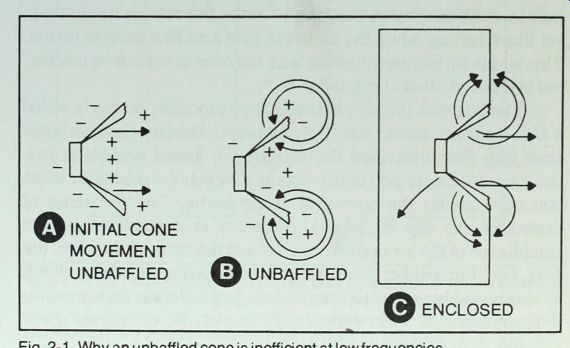
Fig. 2-1 . Why an unbaffled cone is inefficient at low frequencies.
To take full advantage of the compact closed box principle, air suspension speakers must be specially designed. They need longer voice coils so the cone can move farther without carrying the coil too far from the magnet. The cones are also made heavier, which reduces the frequency of resonance and makes for a smoother frequency response curve.
After analyzing earlier large closed box speakers, the engineers who developed the compact acoustic suspension speakers made a clever trade-off. They swapped a large high compliance box for a small box with low air compliance, then to maintain low frequency bass range they replaced the low compliance stiff cone with a loose cone suspension (Fig. 2-2). Note the combinations: loose (large) box, stiff speaker; stiff (small) box, loose speaker.
Almost everyone likes to save space, so the popularity of the compact closed box came as no surprise.
Like all other kinds of speakers, small closed box systems have their disadvantages. The most frequently mentioned one is lack of efficiency. Another weakness, the longer voice coils and greater cone mass in high compliance woofers put a strict upper limit on the woofer's frequency response. This means that with these woofers you must either use a tweeter that will extend well down into the mid-range or go to a 3-way system.
Ported Box Enclosures
Like the closed box, the ported box, or bass reflex, is easy to build; unlike the closed box, its action is complex. If you cut a small hole in a closed speaker box, the air in the box retains its ability to act like a spring, while the air in the hole acts like another piston.
This air piston vibrates in phase with the cone at some frequencies, out of phase at others (Fig. 2-3).
The box with the hole in it acts as a resonator, properly called a Helmholtz resonator, after the nineteenth-century German physicist who first described the behavior of tuned acoustical resonators. An empty pop bottle acts as a Helmholtz resonator when you blow across the open end of the bottle. The frequency of resonance for any Helmholtz resonator is determined by the compliance of the air in the container and the mass of the air in the port. Like the speaker itself, a ported box is a tuned circuit in which a mass resonates against a compliance. At the Helmholtz frequency of resonance, the air in the port vibrates easily, compressing and decompressing the air in the box.
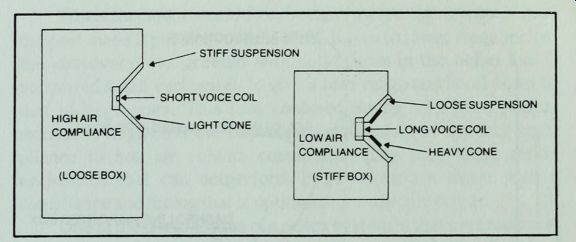
Fig. 2-2. How speaker type affects closed box size.
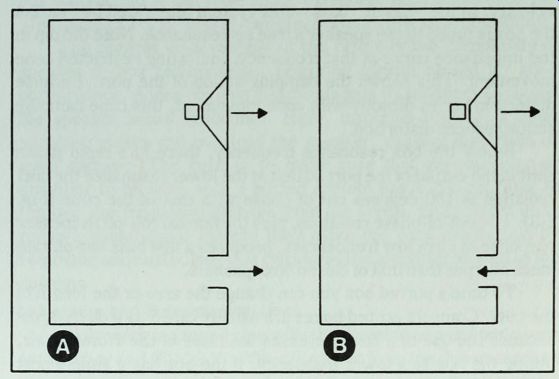
Fig. 2-3. At the frequency to which the box is tuned the port air moves in
phase with the speaker cone, damping it (A). At ultra low frequencies the port
air no longer moves with the cone and the speaker may be unloaded. This disadvantage
of ported speakers can be relieved by use of the infrasonic filter on the receiver
or amplifier.
When a speaker is installed in a ported box, and is closely coupled to the tuned circuit of the box, the original speaker resonance is replaced by two new resonances, one at a higher frequency than the original, the other at a lower frequency (Fig. 2-4). At the upper resonance the air in the port moves in phase with the cone, but, because this frequency is well above that of the box resonance, the damping action is reduced. This is the frequency at which some reflex systems produce too much output, particularly small enclosures whose upper resonance peaks occur within the frequency range of the male voice.
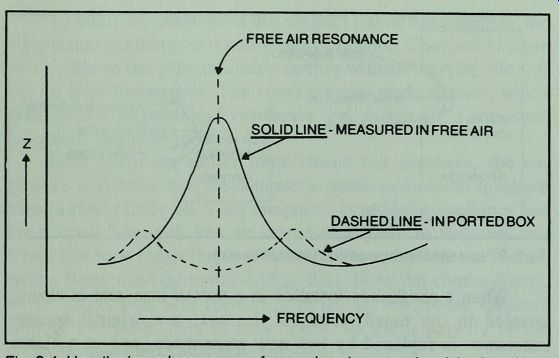
Fig. 2-4. How the impedance curve of a speaker changes when it is placed in
a classic bass reflex enclosure.
If the box is properly tuned, the vibrating air piston works in phase with the cone over a selected band of frequencies to reinforce bass output. This action is most effective at the Helmholtz frequency. Here the port air acts to damp the cone so that it hardly moves, although the port air is moving at maximum velocity. In the "classic" bass reflex system illustrated by Fig. 2-4 the box is tuned to the speaker's free air resonance. Note the dip in the impedance curve at that frequency, indicating restricted cone movement. This shows the damping action of the port. Because distortion varies directly with cone movement, this cone damping action reduces distortion.
Below the box resonance frequency, there is a rapid phase shift in the output of the port so that at the lower resonance the port radiation is 180 degrees out of phase with that of the cone (Fig. 2-3). The out-of-phase radiation, plus the normal roll-off in speaker response at ultra low frequencies, produces a low bass cut-off rate much sharper than that of closed box speakers.
To tune a ported box you can change the area or the length of the port. Compact ported boxes are usually tuned by a ducted port because the use of a duct increases the mass of the vibrating air, tuning the box to a lower frequency. If the box has a simple port with no duct behind it, you can increase the mass of the vibrating air by making the port smaller. While this may seem surprising, a smaller port increases the air velocity and permits the port air to carry more air with it.
When the audio world first became aware that a tube behind the port made it possible to tune small boxes to lower frequencies, this discovery was greeted with enthusiasm in the belief that it permitted small enclosures to give a bass range and level equal to that of large ones. This idea confused tuning with total performance. It neglected the important relationship of speaker compliance to box air volume compliance. The only small reflex enclosures that can outperform larger ones are those with a compliance and tuning that is optimum for a specific driver.
One of the peculiarities of a reflex system is that port radiation does not vary with the size of the port. A small port will radiate just as much sound as a large port, but at higher velocity. If the port is too small, it can produce unmusical noises by its high air velocity.
This weakness of small reflex enclosures can be solved by substituting an extra diaphragm, usually called a passive radiator, for the air in the port. A passive radiator is made like a woofer but has no magnet or voice coil. It can be tuned by changing the mass of the vibrating diaphragm.
The most important advantage of the ported box is its damping control on the speaker. It also offers more efficiency by permitting a more efficient woofer. A woofer designed for a ported box does not have to have as heavy a cone or as long a voice coil as a sealed box woofer, so it can have more extended mid-range response.
This makes a 2-way woofer-tweeter system a practical possibility.
The biggest disadvantage of the reflex is the complexity of speaker to box relationships, requiring careful design for good performance. A less obvious disadvantage is its tendency to unload the speaker below resonance. Here, turntable rumble or other subsonic pulses can overload the speaker, causing distortion or even damage. The cure is to make sure that any receiver or amplifier to be used with a ported system has a low-cut filter to remove low frequency garbage from the signal. Such filters don't remove useful bass; instead they make the bass more solid by removing unheard pulses that can stress the amplifier as well as the speaker.
Labyrinths and Transmission Lines
A labyrinth is a tuned pipe with the driver at one end and a port at the other end (Fig. 2-5). When the wave from the driver reaches the end of the pipe, it expands into the room, causing a sudden pressure drop. This drop in pressure is reflected back through the pipe to the speaker. At the frequency where the length of the pipe is equal to a quarter wavelength (X/4) of the sound, the air at the mouth of the pipe is at minimum velocity, but maximum pressure.
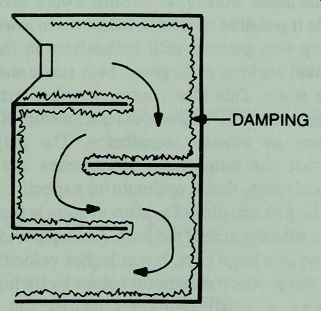
Fig. 2-5. Labyrinth.
At that frequency, the change of pressure is also at a maximum, and the reflection to the speaker of the rarefaction produces maximum damping. A labyrinth that has a length equal to one quarter wavelength at the speaker's resonance frequency will damp the speaker at resonance, an action similar to the bass reflex.
Labyrinths usually have a series of resonant peaks, occurring at harmonics of the fundamental pipe resonance, but these can be subdued by lining the walls with damping material.
A transmission line is a stuffed labyrinth (Fig. 2-6). The theory behind the transmission line was developed by A. R. Bailey, a professor in England. Bailey suggested that reflex enclosures, by their sharp cut-off rates, were likely to produce ringing. He reasoned that an acoustic line behind the speaker that was infinitely long would absorb the back-wave without causing troublesome reflections, but to keep the line within practical limits, he substituted stuffing for length. Extremely low frequency waves are not absorbed by the stuffing but emerge from the mouth of the line to augment the speaker's low bass response. While labyrinths usually have a cross-sectional area that is equal to the speaker cone area, transmission lines are often tapered to spread the resonances. The large end is usually greater in area than the cone, the port end smaller.
Transmission lines have obvious disadvantages. They are large, require a complicated structure, and can be unpredictable.
Fine tuning a transmission line is largely a matter of trial and error.
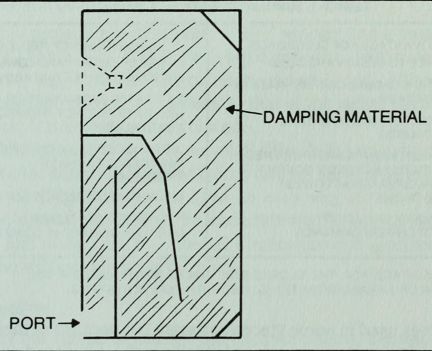
Fig. 2-6. A transmission line enclosure. It differs from the labyrinth by
its taper and stuffing.
Horns
A horn acts as an acoustical transformer. It matches the high acoustical impedance at the driver to the low impedance of the room air by its smooth rate of increased cross-sectional area from the driver cone to the horn mouth (Fig. 2-7). An acoustical megaphone, the kind used by cheerleaders, has some of the virtues of the horn. However, being straight sided, it does not permit the sound waves to expand at a constant rate. As the area of a megaphone increases, the distance between the points where the area doubles also increases. A true horn has a flare which forces the sound waves to expand at a constant rate. Because of its impedance-matching characteristics, a horn offers much higher efficiency than other types of speaker enclosures. The horn permits a lower distortion at high output than any other enclosure because of its high damping on the driver.
The disadvantages are obvious. The size required for a bass horn is tremendous; some are 30 feet long. Folded horns are …
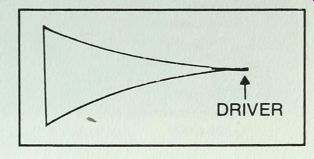
Fig. 2-7. Straight exponential horn.
------------

Table 2-1. Summary: Closed Box vs. Reflex.
ADVANTAGES OF CLOSED BOX
1. SIMPLE TO DESIGN AND BUILD
2. MORE GRADUAL CUT-Of F RATE OF 12dB/OCTAVE
3. GOOD FOR SUB-MINIATURE ENCLOSURES
4. CAN USE WITH HIGHER POWERED AMPLIFIERS BECAUSE IT DOESNT UNLOAD SPEAKER AT LOWEST FREQUENCIES*
5. SPEAKER VARIABILITY HAS LESS EFFECT ON PERFORMANCE
ADVANTAGES OF REFLEX
1. HIGHER OUTPUT AND LOWER DIS TORTION IN OCTAVE ABOVE f b
2. GREATER BASS RANGE OR HIGHER EFFICIENCY FROM EQUAL BOX VOLUME
3. CAN USE SINGLE CONE SPEAKER WITH REDUCED PHASE PROBLEMS
4. LOWER COST BECAUSE OF #3
5. GREATER CHALLENGE GREATER REWARD IF DONE RIGHT
-------------------------------
THIS ADVANTAGE FOR THE CLOSED BOX CAN BE NEUTRALIZED IF AN EQUALIZER OR INFRASONIC FILTER IS USED WITH REFLEX SYSTEMS.
-------------------------
… sometimes used in home stereo systems, but because of their size and complexity, horns are found chiefly in theater sound systems or other high level applications.
WHICH ENCLOSURE IS BEST?
Even if one of the enclosure types described here could be proven to give the best performance in every system, it would not automatically become the universal choice. The bass horn is a good example of a high performance enclosure that is made rare by its cost and complexity. Table 2-1 summarizes the chief advantages of the two most commonly used types of enclosures.
Table 2-2. Parts List for Project 1.
-----------
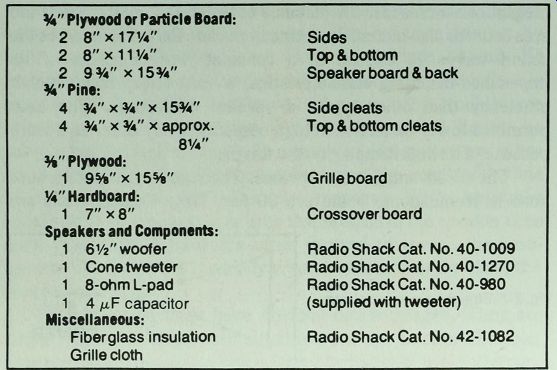
Plywood or Particle Board:
2 8"x17 1/4" Sides
2 8"x1iy4" Top & bottom
2 9 %"x15 %" Speaker board & back
0.75"Pine:
4 %"x %"x15 %" Side cleats
4 %" x %" x approx. Top & bottom cleats
8 1/4"
0.25" Plywood:
1 9 %"x15 %" Grille board 1/4 Hardboard:
1 7"x8" Crossover board
Speakers and Components:
1 6 Vi" woofer Radio Shack Cat. No. 40-1009
1 Cone tweeter Radio Shack Cat. No. 40-1270
1 8-ohm L-pad Radio Shack Cat. No. 40-980
1 4u.F capacitor (supplied with tweeter) Miscellaneous:
Fiberglass insulation
Radio Shack Cat. No. 42-1082 Grille cloth
-------------------
PROJECT 1: A COMPACT TWO-WAY SPEAKER
This project is built around a 6-1/2" woofer and a small cone tweeter (Table 2-2). It is easy to build and wire, requiring only a capacitor, supplied with the tweeter, and an L-pad. Although its bass response doesn't go as deep as that of the larger speakers in this guide, it is smooth and uncolored.
This speaker cabinet is so small (Fig. 2-8) you can probably get left over scraps of plywood from a cabinet shop large enough to do the job (Fig. 2-9). If you have no easy way to make the 45° beveled cuts at the ends of the enclosure walls, you can use butt joints. Just make sure the internal dimensions are approximately the same as those shown in the plans.
Construction
Cut out the parts and set the enclosure shell, the four walls, together to test their fit. It is much easier to install the cleats that hold the speaker board and back panel before assembling the shell, especially in a small enclosure such as this one. Cut and install the side cleats, at least. One way to make them fit properly is to rope or strap the parts together and carefully measure the exact length of cleats needed. If the cleats are too long, they will interfere with further assembly; if too short, there will be gaps. Minor gaps, of about 1/8", can be filled with latex caulking compound or silicone rubber sealant. Install the cleats with glue and nails that are no more than 1 1/4" long. Note that you must leave a space of 1 1/4" at the front and 3/4" at the rear between the cleats and the edges of the panels to accommodate the speaker board and back panel.
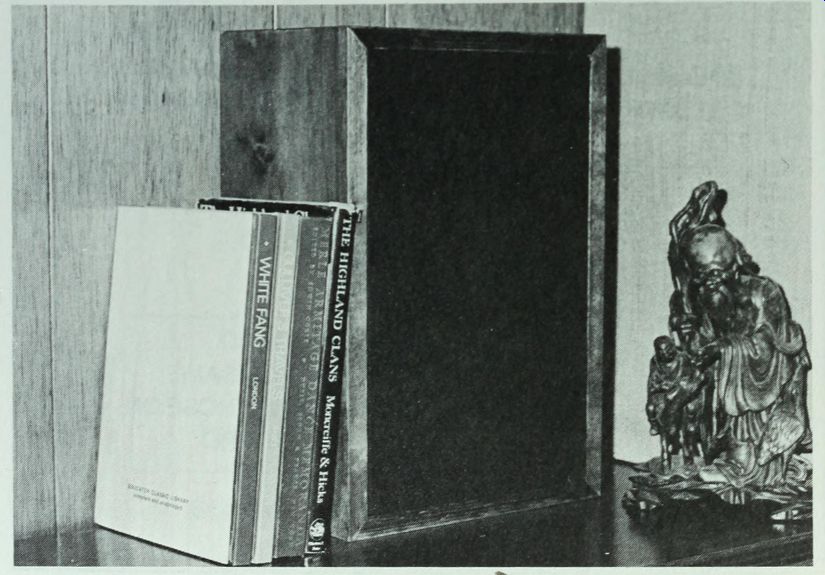
Fig. 2-8.
Finished speaker is small enough for shelf use.
---------------

Fig. 2-9. Construction plans for Project 1 enclosure.
-----------------------

Fig. 2-10. Insert small blocks under straps in middle of each side, as in
upper strap, then move the blocks toward corners of enclosure, as in lower
strap, to apply pressure to corner joints while gluing.
Fig. 2-11. Wiring circuit for Project 1.
If you choose butt joints, use glue and small finishing nails. For the bevel jointed box, as shown, spread a coating of glue on the matching beveled surfaces and rope or strap the box together. To apply pressure to the joints, place small blocks of wood under the ropes or straps near the center of each side, then slide them toward the corners of the box (Fig. 2-10).
Drill the crossover board, according to the plans, and install a set of terminals on the outside with glue and screws. Radio Shack push-button terminals, Cat. No. 274-315, or spring-lever terminals, Cat. No. 274-621, are good choices for this project. Install an L-pad above the terminals. Remove the capacitor from the tweeter and install it between the positive board terminal and pin #3 of the L-pad. Wire the board according to Fig. 2-11. Install the board on the interior surface of the back panel, placing it over a 3" x 4" cut-out in the center of the back. Glue the board to the back with latex caulking compound or silicone rubber sealant; screws are optional unless you plan to work with it while the glue is setting.
This completes the basic enclosure parts: the shell, the speaker board, and the back panel with its crossover board (Fig. 2-12).

Fig. 2-12. Basic enclosure parts.
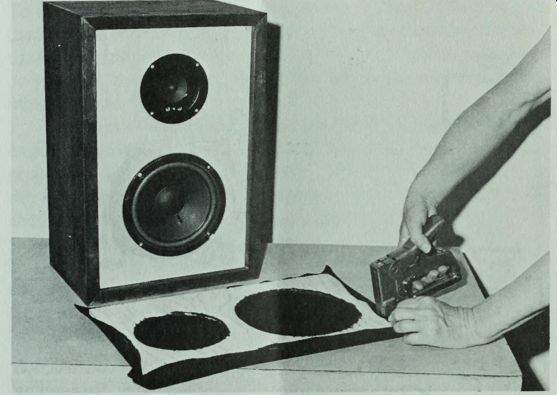
Fig. 2-13. Stretch grille cloth over face of grille board, then staple it
on back of board.
Cover the front edges of the plywood enclosure walls with veneer and stain the box. Do all the finishing work, such as sanding and varnishing before installing the speakers.
Install the speaker board with glue and nails or screws. Caulk the interior joints; then glue and nail down the back. You can reach through the speaker holes to caulk around the back panel. Place the box on its back and loosely fill it with damping material, feeding the speaker leads out through the proper holes. Wire the speakers, soldering the connections. Then run a bead of silicone rubber sealant around each speaker hole, and press the speaker down on the sealant. Leave the box on its back overnight for the glue to set.
Test the speaker by connecting it to a receiver and listening at low volume. Check to see that the treble comes from the tweeter and the bass from the woofer.
Make a grille board and paint the front flat black. Stretch some grille cloth over the front of the board, and staple it on the back (Fig. 2-13). Press the grille board into place. If it fits loosely, use hook and loop retainers.
Place the speaker in its permanent location and adjust the tweeter control. Turn the tweeter volume down, then bring it up until output from the two drivers blends so that you hear them as a single speaker.